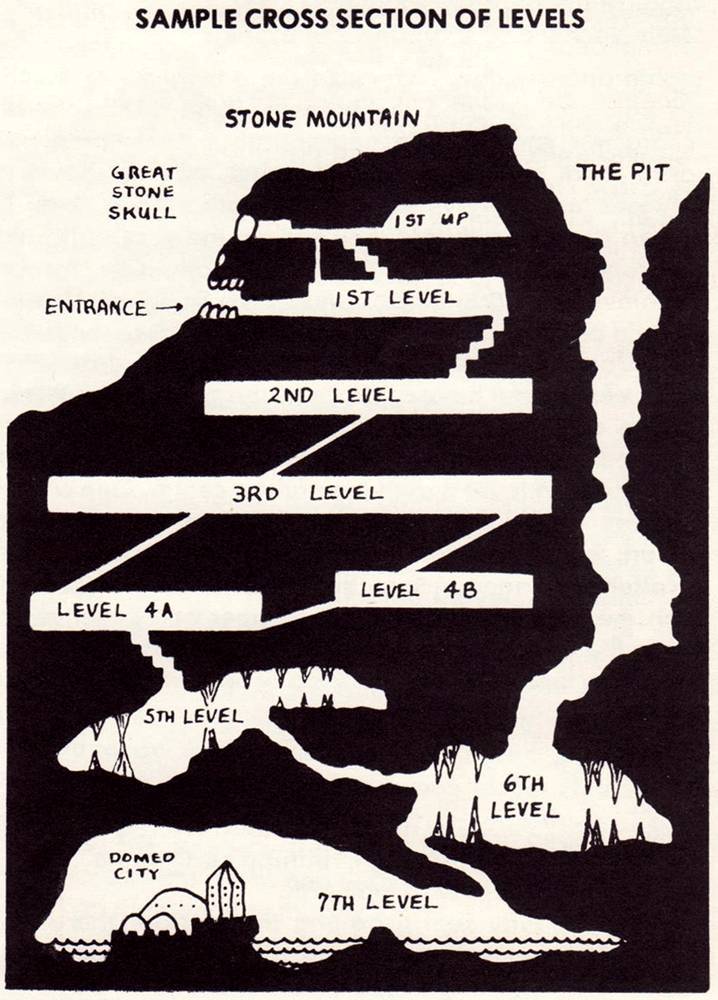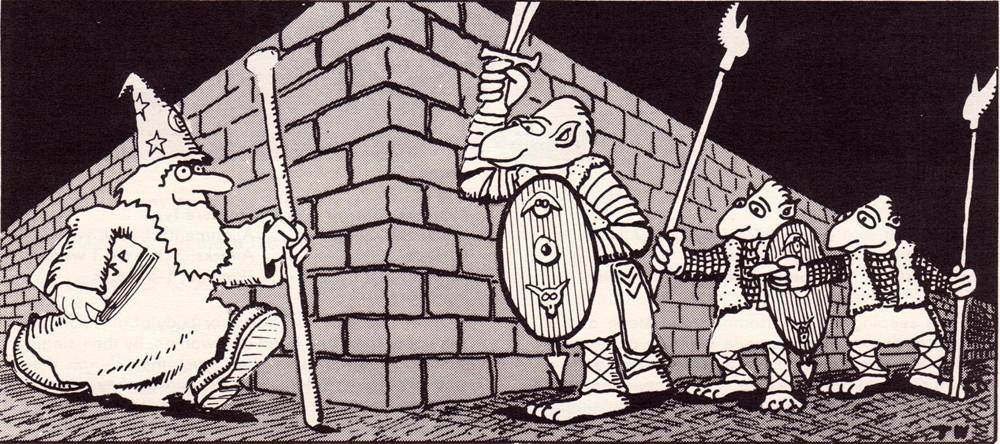
The "Sample Cross Section of Levels", known colloquially as "Skull Mountain", is arguably the most iconic interior art in the Holmes Basic rulebook. No other details about this dungeon are given in the text, but many beginning DMs were inspired by the evocative picture to design their own version.
The work is unsigned, like most TSR dungeon maps, and the rulebook lacks credits for art or cartography, so for the past three decades it hasn't been clear who drew it. One of the other rulebook artists, Holmes himself or his son Chris, or someone else? I assumed David Sutherland as the most likely, because the bulk of the artwork in the rulebook is his, and he later worked on cartography for D&D modules and even drew a cavernous cross-section for the Dungeoneer's Survival Guide. Or perhaps Dave Trampier.
But for some reason I never considered that it was by the third Holmes Basic artist, Tom Wham. Last May on Facebook, Benoist P. posted the above picture to which Tom himself responded, "The black & white image is something I drew back in the 70's for the Dragon Magazine." Obviously this piece was used in the Holmes rulebook rather than Dragon magazine, but looking at it with new eyes I thought - of course! A quick search showed that only Timrod had guessed this previously. Skull Mountain is not in Wham's typical style, but in retrospect the round eye of the skull is perhaps a clue, many characters in his art having round eyes.
Tom started work for TSR in the spring of 1977, with his work appearing as early as
Dragon #5 (March 1977), and credited as a staff artist starting in
Dragon #7 (June 1977). The Holmes Basic rulebook was published in July 1977, so his art for it was among his earliest TSR work. He has only one signed ("TW") artwork in the rulebook, which shows a typically Whamian wizard about to be ambushed by three gnolls armed & armored very similarly to Sutherland's gnoll in the Monster Manual:
A DF poster, Rhuvein, also reported that Tom claims the sword in the Magic Item section:
Late in 1977, Tom's work would also join the two Daves in the original Monster Manual. His beholder is probably his most well-known from that book, but he also illustrated the stag beetle, blink dog, herd animal, giant lynx, mind flayer, giant pike, and three of the four sphinxes. Each of these signed with a tiny "TW". There are possibly other drawings of his where the signature is obscured or cut-off. Some, like the giant lynx, giant pike and mind flayer are in his typical cartoon style, but others like the stag beetle, blink dog and sphinxes, are more naturalistic.
Tom didn't illustrate many other dungeon cross-sections, but he did illustrate many other cross-sections, often as boards for the games he designed. His second game published by TSR in Dragon #11, Snit's Revenge, featured a large cross-section of a Bolotomus:
:strip_icc()/pic3212.jpg) |
Snit's Revenge board, original version from Dragon #11, Dec 1977
|
 |
TAGTOS board, original version from Dragon #22, Aug 1979
|
Note that in both of these game boards the individual rooms are each lettered in comic-book-style block capitals, the same as in Skull Mountain.
Here's a rare magazine cover by Tom, for Polyhedron #29 in 1986, showing the cross-section of a tower filled with busy inhabitants:
And more than a decade after Holmes Basic, he included another underground cross-section as one of the boards in his Mertwig's Maze (1988, TSR), the "Caves of Congor":
See also Tom Wham's website, with lots of historical information about his games.
* * * * *
In my next post I'll look at the Sample Cross-Section in the Holmes Manuscript.
* * * * *















:strip_icc()/pic3212.jpg)

:strip_icc()/pic4597480.jpg)
:strip_icc()/pic130441.jpg)





